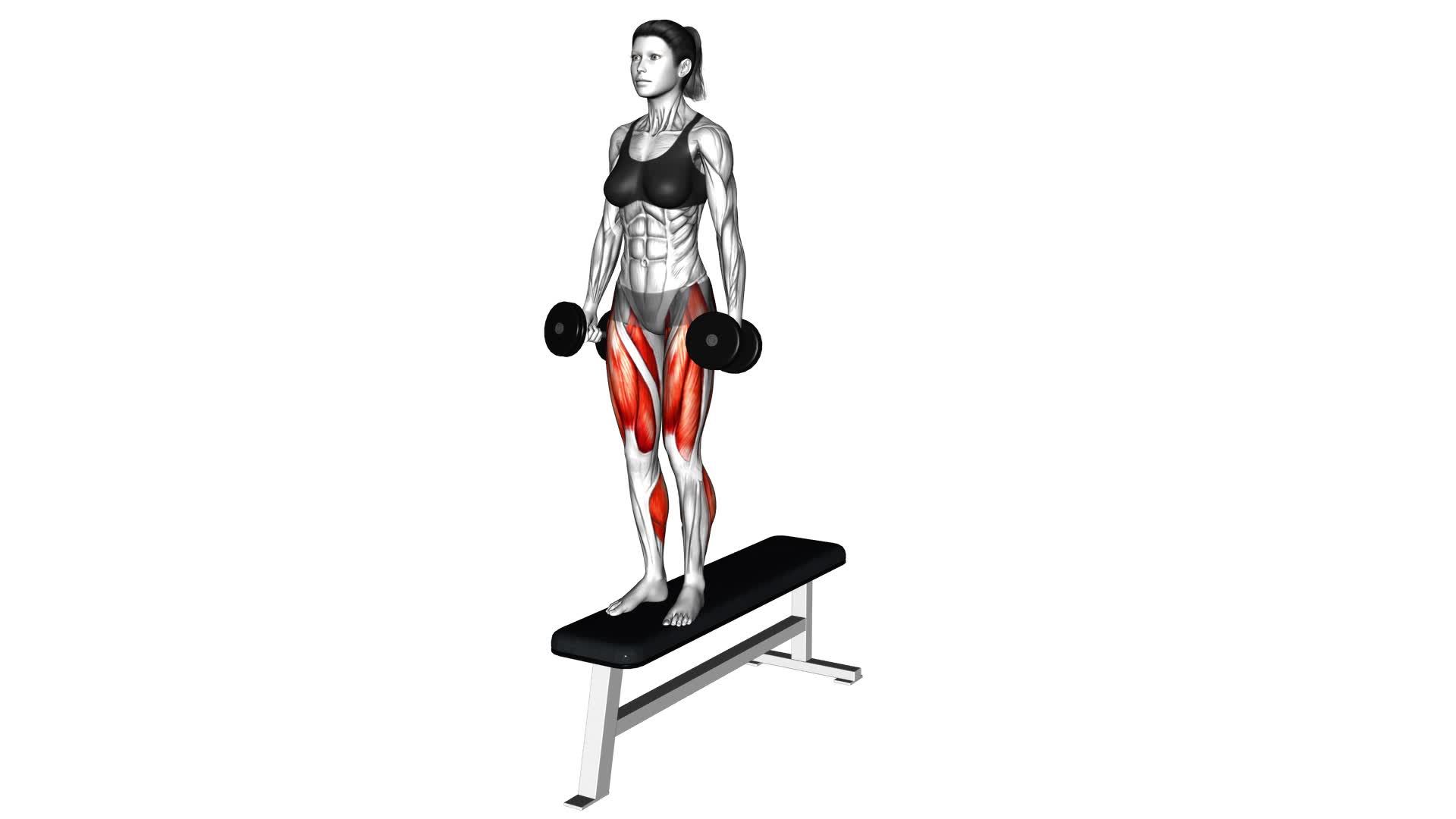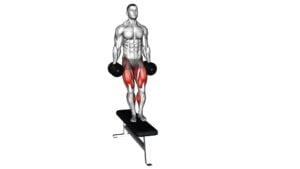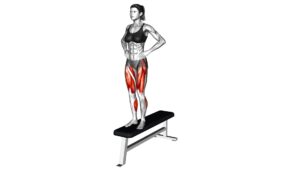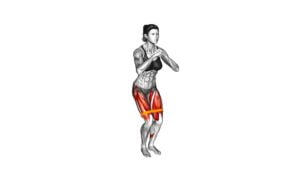Dumbbell Lateral Step-up (female) – Video Exercise Guide & Tips

Looking to tone your legs and improve your balance? The dumbbell lateral step-up is a fantastic exercise for you.
Watch This Exercise Video
In this video exercise guide, we'll show you how to perform this move with proper form and technique. You'll also learn how to choose the right weight and avoid common mistakes.
Plus, we'll provide variations and progressions to keep challenging yourself.
Get ready to incorporate the dumbbell lateral step-up into your workout routine and achieve those fitness goals!
Key Takeaways
- Dumbbell lateral step-up is highly effective for increasing strength and improving balance.
- It targets leg muscles, particularly the quadriceps, hamstrings, and glutes, and incorporating dumbbells adds resistance to build and tone these muscles.
- Engaging core muscles during the exercise improves stability, balance, and coordination.
- Proper form and technique are crucial to maximize the benefits of the exercise and prevent injuries.
Benefits of the Dumbbell Lateral Step-up
Improve your strength and stability with the dumbbell lateral step-up. This exercise is highly effective for increasing strength and improving balance. By incorporating dumbbells into your lateral step-up routine, you're adding resistance to your workout, which helps to build and tone your leg muscles, particularly the quadriceps, hamstrings, and glutes.
The dumbbell lateral step-up targets these muscles as you lift your body weight onto a step or platform, using the strength of your legs. The added weight of the dumbbells challenges your muscles even more, leading to increased strength and muscle growth over time. This exercise also helps to improve your balance as you engage your core muscles to stabilize yourself during the movement.
To perform the dumbbell lateral step-up, start by standing beside a step or platform with dumbbells in each hand. Place one foot on the step, and press through your heel to lift your body up onto the step. Keep your core engaged and maintain a steady pace throughout the exercise. Repeat the movement with the other leg.
Incorporating the dumbbell lateral step-up into your fitness routine will help you develop stronger leg muscles while enhancing your overall balance.
Proper Form and Technique
To perform the dumbbell lateral step-up with proper form and technique, you need to focus on maintaining a stable and controlled movement. This exercise isn't only great for improving balance but also for increasing lower body strength.
Start by standing next to a step or platform with a dumbbell in each hand, palms facing your body. Keep your feet shoulder-width apart and your core engaged. Begin the movement by stepping up onto the platform with your right foot, driving through your heel. As you step up, lift your left knee towards your chest, maintaining a 90-degree angle at your hip and knee.
Pause briefly at the top of the movement, ensuring that your right foot is fully planted on the platform. Then, slowly lower your left foot back to the ground while simultaneously lowering your right foot back to the starting position. Repeat the movement on the opposite side.
Throughout the exercise, it's important to maintain proper form and control. Avoid leaning forward or backward, and keep your chest lifted and shoulders back. Focus on using your glutes and leg muscles to power the movement, rather than relying on momentum.
Choosing the Right Weight
When selecting the appropriate weight for the dumbbell lateral step-up, continue the discussion from the previous subtopic by considering your individual strength and capabilities. Weight selection is crucial in order to modify the intensity of the exercise and ensure that you challenge yourself without risking injury.
To determine the right weight for you, start by assessing your current fitness level. If you're a beginner or have limited strength, it's advisable to start with lighter dumbbells, such as 5 or 8 pounds. As you become more comfortable with the exercise and feel that it's no longer challenging enough, you can gradually increase the weight.
On the other hand, if you're already experienced and have a higher level of strength, you may want to begin with heavier dumbbells, such as 10 or 12 pounds. It's important to find a weight that allows you to perform the exercise with proper form and technique, but also provides enough resistance to stimulate muscle growth.
Remember, the goal is to find a weight that challenges you, but doesn't compromise your form or put excessive strain on your joints. By selecting the right weight, you can effectively modify the intensity of the exercise and continue progressing towards your fitness goals.
Now that you understand the importance of weight selection, let's move on to discussing some common mistakes to avoid when performing the dumbbell lateral step-up.
Common Mistakes to Avoid
When performing the dumbbell lateral step-up exercise, it's important to be aware of common mistakes to avoid. Incorrect form can lead to potential dangers such as strain or injury to your muscles.
Additionally, overestimating your weight capacity can hinder your progress and prevent you from achieving optimal results.
Incorrect Form Dangers
To prevent potential injuries and maximize the effectiveness of your dumbbell lateral step-up exercise, be sure to avoid these common mistakes in your form.
- Using too much weight: Overloading the exercise can strain your muscles and joints, increasing the risk of injury. Start with a weight that challenges you but still allows for proper form.
- Leaning forward or backward: Maintaining an upright posture is crucial for targeting the correct muscles and preventing strain on your back and knees.
- Not fully extending your leg: Failing to fully extend your leg at the top of the movement reduces the effectiveness of the exercise and can lead to muscle imbalances.
- Rushing through the exercise: Performing the step-up too quickly can compromise your form and increase the risk of tripping or losing balance.
Overestimating Weight Capacity
Don't overestimate your weight capacity when performing dumbbell lateral step-ups. It's important to accurately estimate the amount of weight you can handle to avoid injuries. Overloading yourself with too much weight can put excessive strain on your muscles and joints, increasing the risk of strains, sprains, or even more serious injuries.
When determining your weight capacity, start with a weight that allows you to perform the exercise with proper form and technique. Gradually increase the weight as you become more comfortable and confident in your ability. Remember to listen to your body and avoid pushing yourself too hard too soon.
By properly estimating your weight capacity, you can ensure a safe and effective workout.
Now, let's move on to explore variations and progressions of the dumbbell lateral step-up.
Variations and Progressions
Looking to challenge yourself with the Dumbbell Lateral Step-up exercise? Here are some variations and progressions that you can try to take your workout to the next level:
- Elevated Step-up: Place your foot on an elevated platform, such as a step or bench, to increase the height and difficulty of the exercise.
- Weighted Step-up: Hold a dumbbell in each hand while performing the step-up to add resistance and further engage your muscles.
- Single-leg Step-up: Perform the exercise on one leg at a time to increase the stability challenge and activate your core muscles more effectively.
- Plyometric Step-up: Add a explosive jump or hop at the top of the movement to incorporate plyometric training and improve power and explosiveness.
These advanced modifications can help you target different muscles, increase the intensity of your workout, and provide a new challenge for your body. Remember to start with lighter weights or lower platforms and gradually increase the difficulty as your strength and stability improve.
Incorporating the dumbbell lateral step-up into your workout routine can help improve lower body strength, stability, and balance. Now, let's move on to the next section to learn how to effectively include this exercise in your fitness regimen.
Incorporating the Dumbbell Lateral Step-Up Into Your Workout Routine
To effectively incorporate the Dumbbell Lateral Step-Up into your workout routine, you can begin by selecting an appropriate weight dumbbell and a stable platform to step onto.
This exercise is highly beneficial for targeting and strengthening your glutes. By stepping laterally onto the platform, you're engaging the muscles in your hips, thighs, and glutes, resulting in increased strength and stability.
To perform the Dumbbell Lateral Step-Up, stand next to the platform with your feet hip-width apart. Hold the dumbbell in one hand, allowing it to hang by your side. Step onto the platform with the same-side foot, pushing through your heel to lift your body up onto the platform.
As you raise your body, squeeze your glutes to maximize the engagement of these muscles. Lower yourself back down to the starting position in a controlled manner.
For advanced fitness levels, you can increase the difficulty of the exercise by adding more weight to the dumbbell or using a higher platform. Another variation is to perform the step-up with a knee drive, where you lift your knee towards your chest after stepping onto the platform.
These variations will challenge your balance and coordination while further targeting the glute muscles.
Frequently Asked Questions
How Many Calories Does the Dumbbell Lateral Step-Up Burn?
The dumbbell lateral step-up is a great exercise for burning calories. It targets your legs, glutes, and core, making it an effective full-body movement.
The exact number of calories burned will vary based on factors such as your weight, intensity, and duration of the exercise. However, on average, this exercise can help you burn around 6-8 calories per minute.
Keep in mind that if you have any injuries, there are modifications available to ensure you can still perform this exercise safely.
Are There Any Modifications for People With Knee or Hip Issues?
If you have knee or hip issues, there are modifications you can make to the dumbbell lateral step-up exercise. Instead of using dumbbells, you can start by using just your body weight.
You can also try alternative exercises like lateral leg lifts or clamshells, which are less stressful on the knees and hips.
Remember to consult with a healthcare professional or a certified trainer to determine the best modifications for your specific condition.
Can I Do the Dumbbell Lateral Step-Up Without Weights?
Yes, you can definitely do the dumbbell lateral step-up without weights. This variation of the exercise is a great option if you don't have access to dumbbells or if you're just starting out and want to build up your strength gradually.
While using weights can increase the intensity and target specific muscle groups, performing the exercise without weights still provides benefits like improving balance, stability, and strengthening your lower body muscles.
How Often Should I Perform the Dumbbell Lateral Step-Up in My Workout Routine?
To get the most out of your workout routine, it's important to know how often to perform the dumbbell lateral step-up.
This exercise offers numerous benefits for women, such as strengthening your legs, glutes, and core. It also improves balance and stability.
As for variations, you can try different weights, heights, or even add a knee lift at the end.
Remember to listen to your body and start with a weight that challenges you but is still manageable.
Does the Dumbbell Lateral Step-Up Help in Improving Balance and Stability?
The dumbbell lateral step-up is a great exercise for improving coordination, balance, and stability. It can be beneficial for athletes looking to enhance their performance. By incorporating this exercise into your routine, you'll challenge your body to maintain control and stability while stepping up laterally.
This movement engages your core, glutes, and leg muscles, helping to develop strength and stability in those areas.
Conclusion
In conclusion, the dumbbell lateral step-up is a highly effective exercise for targeting the lower body, particularly the glutes, quads, and hamstrings. By incorporating this exercise into your workout routine, you can improve strength, stability, and balance.
Remember to maintain proper form and choose the appropriate weight to challenge yourself without compromising your technique. Avoid common mistakes and explore variations and progressions to continually challenge your muscles.
Get ready to take your lower body workouts to the next level with the dumbbell lateral step-up.

Author
Years ago, the spark of my life’s passion ignited in my mind the moment I stepped into the local gym for the first time. The inaugural bead of perspiration, the initial endeavor, the very first surge of endorphins, and a sense of pride that washed over me post-workout marked the beginning of my deep-seated interest in strength sports, fitness, and sports nutrition. This very curiosity blossomed rapidly into a profound fascination, propelling me to earn a Master’s degree in Physical Education from the Academy of Physical Education in Krakow, followed by a Sports Manager diploma from the Jagiellonian University. My journey of growth led me to gain more specialized qualifications, such as being a certified personal trainer with a focus on sports dietetics, a lifeguard, and an instructor for wellness and corrective gymnastics. Theoretical knowledge paired seamlessly with practical experience, reinforcing my belief that the transformation of individuals under my guidance was also a reflection of my personal growth. This belief holds true even today. Each day, I strive to push the boundaries and explore new realms. These realms gently elevate me to greater heights. The unique combination of passion for my field and the continuous quest for growth fuels my drive to break new ground.



